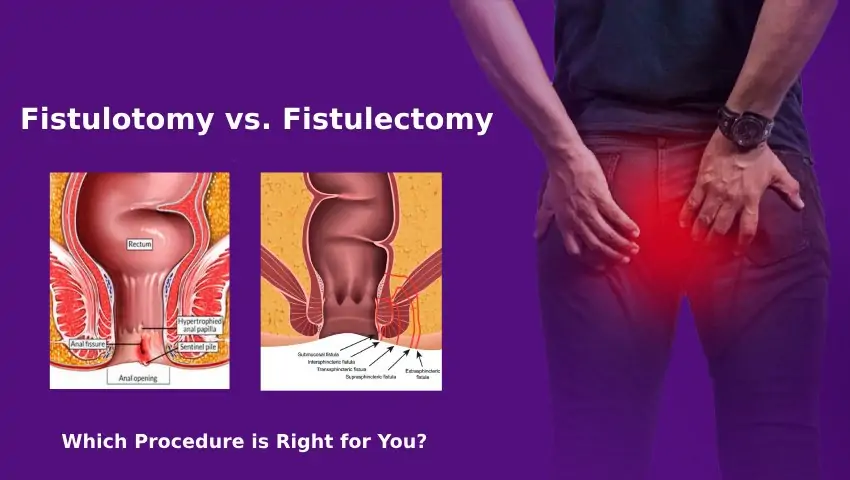What is Fistulotomy / Fistulectomy?
A fistula is an abnormal connection between two body parts, commonly forming between the anal canal and the skin near the anus (known as an anal fistula). Two common surgical treatments for anal fistulas are fistulotomy and fistulectomy.
Fistulotomy involves opening the fistulous tract and allowing it to heal from the inside out.
Fistulectomy involves the complete removal (excision) of the entire fistula tract.
Both procedures aim to eliminate the fistula, promote healing, and prevent recurrence or complications such as infection or abscess formation.

Symptoms of Anal Fistula
If you are experiencing any of the following symptoms, it may indicate an anal fistula:
- Persistent pain or swelling near the anus
- Discharge of pus or blood from a small hole near the anus
- Skin irritation or itching around the anal area
- Recurring abscesses
- Painful bowel movements
- Fever and fatigue (if infection is present)
Early diagnosis and treatment can prevent the condition from worsening.
Causes of Anal Fistula
Anal fistulas are often the result of:
- An anal abscess that did not heal properly
- Infections in the anal glands
- Inflammatory bowel diseases like Crohn’s disease or ulcerative colitis
- Tuberculosis or sexually transmitted infections (rare causes)
- Trauma or previous surgeries in the anal region
Types of Anal Fistulas
Fistulas are classified based on their path relative to the anal sphincter muscles:
Intersphincteric Fistula
Transsphincteric Fistula
Suprasphincteric Fistula
Extrasphincteric Fistula
Subcutaneous (low) Fistula
The treatment method depends on the type and complexity of the fistula.
Diagnosis
Diagnosis usually includes:
- Physical examination
- Proctoscopy
- MRI or ultrasound of the anal region
- Fistulogram in complex cases
Treatment: Fistulotomy vs. Fistulectomy
Fistulotomy
The surgeon cuts open the fistula tract to allow it to heal naturally.
Preferred for simple, low-lying fistulas.
Minimally invasive and has a faster healing time.
Carried out under local, spinal, or general anesthesia.
Fistulectomy
The surgeon completely excises the entire fistula tract.
Recommended for complex or recurring fistulas.
Requires more healing time compared to fistulotomy.
May be performed using traditional surgery or laser techniques.
Postoperative Care
Maintain hygiene of the anal area
Use sitz baths for comfort and faster healing
Pain management with prescribed medications
High-fiber diet and plenty of fluids
Regular follow-ups with the surg
Prevention Tips
While not all fistulas can be prevented, the risk can be reduced by:
Prompt treatment of anal abscesses and infections
Managing conditions like Crohn’s disease or tuberculosis effectively
Maintaining good anal hygiene
Avoiding constipation and straining during bowel movements
Benefits of Fistulotomy / Fistulectomy
Permanent relief from chronic infection and discharge
Reduced risk of abscess recurrence
Restores normal bowel movements and anal function
Enhances overall quality of life
Minimally invasive options now available (e.g., laser fistula treatment)
